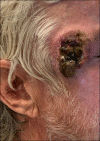Devastating effect of untreated facial squamous cell carcinoma
- PMID: 34456488
- PMCID: PMC8366926
- DOI: 10.1080/08998280.2021.1925065
Devastating effect of untreated facial squamous cell carcinoma
Abstract
Skin cancer develops primarily on areas of sun-exposed skin and can typically be treated if caught early. Here, we present a case of a 57-year-old man who presented with an extremely large facial squamous cell carcinoma with resulting perineural invasion and metastasis to parotid lymph nodes because he was unable to obtain timely treatment.
Keywords: Skin cancer; squamous cell carcinoma.
Copyright © 2021 Baylor University Medical Center.
Figures


Similar articles
-
Facial squamous carcinoma with parotid metastasis--closure with cheek-neck rotation.J Otolaryngol. 1984 Jun;13(3):137-40. J Otolaryngol. 1984. PMID: 6544827
-
Head and neck cutaneous squamous cell carcinoma requiring parotidectomy: prognostic indicators and treatment selection.Otolaryngol Head Neck Surg. 2014 Apr;150(4):610-7. doi: 10.1177/0194599814520686. Epub 2014 Jan 28. Otolaryngol Head Neck Surg. 2014. PMID: 24474713
-
[Auricular Acantholytic Squamous Cell Carcinoma with Neck Metastasis and Lethal Outcome - Case Report].Srp Arh Celok Lek. 2015 Sep-Oct;143(9-10):599-603. doi: 10.2298/sarh1510599j. Srp Arh Celok Lek. 2015. PMID: 26727870 Serbian.
-
Scalp junctional nevus with malignant transformation (melanoma) metastatic to parotid lymph node region, cervical lymph nodes and the back: a case report and review of literature.Int J Clin Exp Pathol. 2015 Jan 1;8(1):954-9. eCollection 2015. Int J Clin Exp Pathol. 2015. PMID: 25755802 Free PMC article. Review.
-
[Squamous cell carcinoma of the parotid gland in children].Nihon Jibiinkoka Gakkai Kaiho. 1996 Jul;99(7):999-1003. doi: 10.3950/jibiinkoka.99.999. Nihon Jibiinkoka Gakkai Kaiho. 1996. PMID: 8776973 Review. Japanese.
References
-
- Baldi A, Pasquali P, Spugnini E.. Skin Cancer: A Practical Approach. New York: Springer; 2014: 17–164.
Publication types
LinkOut - more resources
Full Text Sources
